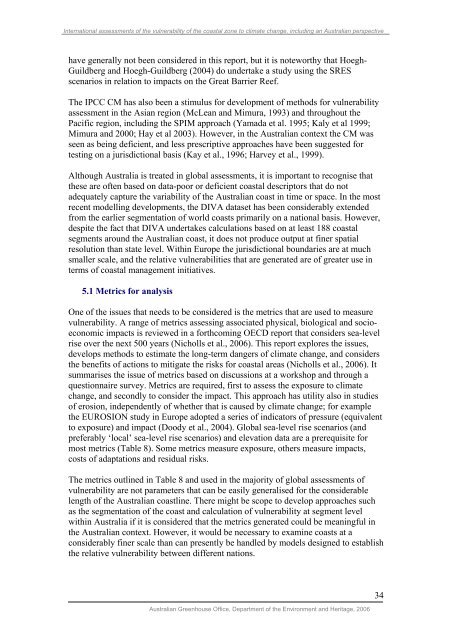International assessments of the vulnerability.pdf - Climate ...
International assessments of the vulnerability.pdf - Climate ...
International assessments of the vulnerability.pdf - Climate ...
Create successful ePaper yourself
Turn your PDF publications into a flip-book with our unique Google optimized e-Paper software.
<strong>International</strong> <strong>assessments</strong> <strong>of</strong> <strong>the</strong> <strong>vulnerability</strong> <strong>of</strong> <strong>the</strong> coastal zone to climate change, including an Australian perspective<br />
have generally not been considered in this report, but it is noteworthy that Hoegh-<br />
Guildberg and Hoegh-Guildberg (2004) do undertake a study using <strong>the</strong> SRES<br />
scenarios in relation to impacts on <strong>the</strong> Great Barrier Reef.<br />
The IPCC CM has also been a stimulus for development <strong>of</strong> methods for <strong>vulnerability</strong><br />
assessment in <strong>the</strong> Asian region (McLean and Mimura, 1993) and throughout <strong>the</strong><br />
Pacific region, including <strong>the</strong> SPIM approach (Yamada et al. 1995; Kaly et al 1999;<br />
Mimura and 2000; Hay et al 2003). However, in <strong>the</strong> Australian context <strong>the</strong> CM was<br />
seen as being deficient, and less prescriptive approaches have been suggested for<br />
testing on a jurisdictional basis (Kay et al., 1996; Harvey et al., 1999).<br />
Although Australia is treated in global <strong>assessments</strong>, it is important to recognise that<br />
<strong>the</strong>se are <strong>of</strong>ten based on data-poor or deficient coastal descriptors that do not<br />
adequately capture <strong>the</strong> variability <strong>of</strong> <strong>the</strong> Australian coast in time or space. In <strong>the</strong> most<br />
recent modelling developments, <strong>the</strong> DIVA dataset has been considerably extended<br />
from <strong>the</strong> earlier segmentation <strong>of</strong> world coasts primarily on a national basis. However,<br />
despite <strong>the</strong> fact that DIVA undertakes calculations based on at least 188 coastal<br />
segments around <strong>the</strong> Australian coast, it does not produce output at finer spatial<br />
resolution than state level. Within Europe <strong>the</strong> jurisdictional boundaries are at much<br />
smaller scale, and <strong>the</strong> relative vulnerabilities that are generated are <strong>of</strong> greater use in<br />
terms <strong>of</strong> coastal management initiatives.<br />
5.1 Metrics for analysis<br />
One <strong>of</strong> <strong>the</strong> issues that needs to be considered is <strong>the</strong> metrics that are used to measure<br />
<strong>vulnerability</strong>. A range <strong>of</strong> metrics assessing associated physical, biological and socioeconomic<br />
impacts is reviewed in a forthcoming OECD report that considers sea-level<br />
rise over <strong>the</strong> next 500 years (Nicholls et al., 2006). This report explores <strong>the</strong> issues,<br />
develops methods to estimate <strong>the</strong> long-term dangers <strong>of</strong> climate change, and considers<br />
<strong>the</strong> benefits <strong>of</strong> actions to mitigate <strong>the</strong> risks for coastal areas (Nicholls et al., 2006). It<br />
summarises <strong>the</strong> issue <strong>of</strong> metrics based on discussions at a workshop and through a<br />
questionnaire survey. Metrics are required, first to assess <strong>the</strong> exposure to climate<br />
change, and secondly to consider <strong>the</strong> impact. This approach has utility also in studies<br />
<strong>of</strong> erosion, independently <strong>of</strong> whe<strong>the</strong>r that is caused by climate change; for example<br />
<strong>the</strong> EUROSION study in Europe adopted a series <strong>of</strong> indicators <strong>of</strong> pressure (equivalent<br />
to exposure) and impact (Doody et al., 2004). Global sea-level rise scenarios (and<br />
preferably ‘local’ sea-level rise scenarios) and elevation data are a prerequisite for<br />
most metrics (Table 8). Some metrics measure exposure, o<strong>the</strong>rs measure impacts,<br />
costs <strong>of</strong> adaptations and residual risks.<br />
The metrics outlined in Table 8 and used in <strong>the</strong> majority <strong>of</strong> global <strong>assessments</strong> <strong>of</strong><br />
<strong>vulnerability</strong> are not parameters that can be easily generalised for <strong>the</strong> considerable<br />
length <strong>of</strong> <strong>the</strong> Australian coastline. There might be scope to develop approaches such<br />
as <strong>the</strong> segmentation <strong>of</strong> <strong>the</strong> coast and calculation <strong>of</strong> <strong>vulnerability</strong> at segment level<br />
within Australia if it is considered that <strong>the</strong> metrics generated could be meaningful in<br />
<strong>the</strong> Australian context. However, it would be necessary to examine coasts at a<br />
considerably finer scale than can presently be handled by models designed to establish<br />
<strong>the</strong> relative <strong>vulnerability</strong> between different nations.<br />
Australian Greenhouse Office, Department <strong>of</strong> <strong>the</strong> Environment and Heritage, 2006<br />
34

















